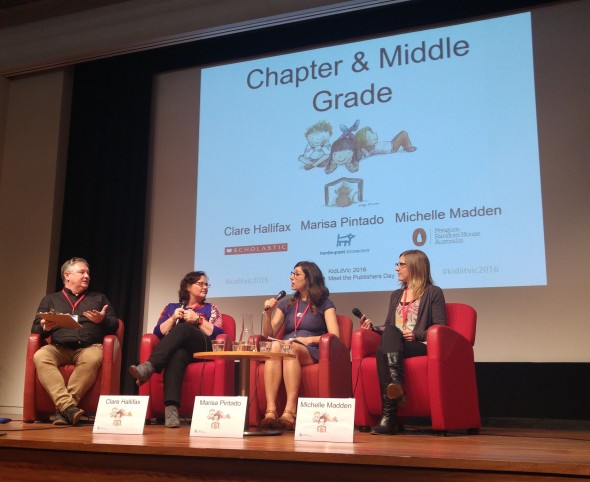There were so many thought-provoking topics discussed at KidLitVic (see Part 1 for an intro), from gender and diversity in children’s books to what publishers are looking for. Did you know:
- Picture books are submitted to publishers in far greater quantities than other types of kids’ books (junior fiction and beyond). For example, Melissa Keil of Five Mile Press said for them, it’s around a 30:1 ratio.
- There is a need for more children’s books featuring female protagonists. From Melissa Keil: only 1 in 11 of their current picture books feature a female lead character(!)
- There are exceptions to every ‘rule’. For example, picture book authors are commonly told the publisher will source the illustrator, however in the case of Scribble (a new imprint by Scribe), publisher Miriam Rosenbloom said they actually like being approached by an author/illustrator pair.
More from the panels:
- Other interesting revelations from the Picture Book panel (Melissa Keil, Miriam Rosenbloom and Maryann Ballantyne from Black Dog Books) included picture book word lengths not always mattering (i.e. you don’t necessarily have to stick to the under 500 word guide most often mentioned). You can also submit 2-3 manuscripts at once.
- The Chapter Book/Middle Grade panel, featuring Clare Hallifax (Scholastic), Marisa Pintado (Hardie Grant Egmont) and Michelle Madden (Penguin Random House), discussed the idea that boys will read chapter books featuring girls, but may feel social pressure to hide it. All revealed their penchant for publishing non-gender specific characters and concepts, however Clare Hallifax commented that young readers often want something gender specific. ‘I hate it, but it is a reality,’ she said.
- Marisa Pintado and Michelle Madden prefer chapter books that are part of a series, however Clare Hallifax doesn’t mind standalone titles, especially if they can later be packaged with other books by the same author.
- For illustrators, showcasing your work on websites like The Style File is invaluable. The Illustration panel (Jacinta di Mase (literary agent), Kimberley Bennett (Random House) and Suzanne O’Sullivan (Lothian/Hachette) mentioned they visit this for ideas and sourcing talent.
- In the world of YA, paranormal is out. Lisa Berryman of HarperCollins said she receives ‘too much fantasy and paranormal’, while Elise Jones of Allen & Unwin said ‘publishers and booksellers are sick of dystopian’, even if readers aren’t yet.
There is so much more I could tell you – but if you write or illustrate children’s books, you might just have to come to the hotly anticipated 2017 event! A few more attendees have done some fabulous write-ups too:
- Sylvia Morris includes some helpful links on permission protocols if writing from a cultural perspective that’s not your own (with some specific advice relating to indigenous content)
- Ramona Davey features some great snapshots of what each of the presenters like (oh, and a pic of our lovely critique group too 🙂 )
- Megan Higginson has a detailed, fly on the wall account that will make you feel like you were there, even if you weren’t

